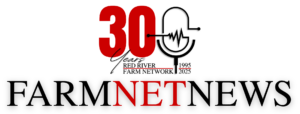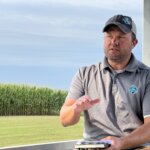
A Weekly Update from the Red River Farm Network
Tuesday, April 02, 2024

A Milestone – The man who set the standard for farm broadcasting, Orion Samuelson, celebrated a milestone birthday over the weekend. At 90 years old, the ‘Big O’ spent 68 years on the radio. In addition, Orion and Max Armstrong were on our television screen every weekend with U.S. Farm Report and This Week in Agribusiness. With that big booming voice, Orion traveled the country giving speeches and doing interviews. Anyone who has ever opened a microphone to deliver farm news or markets must give credit to Orion for being the best possible example of farm broadcasting. The Red River Farm Network extends our best wishes to Orion. Happy Birthday and Thank You.
A Bullish Corn Acreage Estimate – USDA is estimating corn acreage at 90 million acres, down five percent of 4.6 million acres from last year and well below trade expectations. The planted area for soybeans is forecast at 86.5 million acres, a three percent increase from last year and slightly higher than the average trade guess. Corn stocks on March 1 totaled 8.3 billion bushels, 13 percent higher than a year ago. Soybean stocks were reported at 1.8 billion bushels, up nine percent.
Where Have All the Acres Gone? – The big takeaway from USDA’s Planting Intentions Report was the total acreage numbers that were down from last year. RCM Director of Risk Management Steve Wagner wants to know where they went. “Last year we had 253.8 million acres of total crop and this year it’s 248.9 million. It begs the question, where did they go? Are they going to hay? Are they just going to be fallow?” Wagner says the answer is something to watch for in the coming weeks as planting season arrives across the Midwest.

Farmers to Cut Back on Acres – Global Commodity Analytics President Mike Zuzolo doesn’t think USDA’s acreage number is too far out of line. “I think what we can glean from this is that between the bean-corn ratio, the crop insurance base price and the cost of production differentials between this year versus last year going into planting, the farmer is really pulling in his horns at this point.” Total Farm Marketing Market Advisor John Heinberg said the data did have some impact with a friendly corn number. “Now we’re going to start shifting things back to the weather side of the equation in the U.S.” said Heinberg. “The planting window is coming.”
The Last Word – The Prospective Plantings Report is USDA’s best acreage guess before most planters begin to roll. USDA Chief Economist Seth Meyer said weather remains the wild card. “Weather always has the last say, right? When we think about a lot of things we shift principal crop acres actually planted, not intention, but actually planted, it’s often things like weather and prevent plant from year to year that are the big drivers.”

A Notable Change in Tri-State Crop Mix – Soybean acres in North Dakota are expected to increase dramatically, up more than 11 percent than last year. In Minnesota and South Dakota, farmers intend to increase soybean planted acreage by two percent. For corn, planted acreage is forecast to be down or unchanged in 38 of the 48 states. Corn acres are expected to be down more than eight percent in Minnesota; down more than six percent in North Dakota and down nearly five percent in South Dakota. Spring wheat acres will be up dramatically in Minnesota and South Dakota, but down in North Dakota. North Dakota remains the largest spring wheat-producing state at 5.3 million acres, but that’s down 4.5 percent from 2023. Spring wheat acres are projected to increase more than 23 percent in Minnesota and nearly 15 percent in South Dakota.
A Record Canola Year – Canola acreage is forecast to be record high this year at 2.37 million acres. North Dakota is the leading canola-producing state, but planting intentions are down seven percent this year. That would still be North Dakota’s second-highest planted area on record. In Minnesota, canola acres are forecast to be up 20 percent.
Canola Minute – Here’s the latest Canola Minute from the Northern Canola Growers Association. This week, Northern Canola Growers Association Executive Director Barry Coleman provided the latest canola oil production numbers from the U.S. Energy Information Administration. Canola seed imports from Canada are expected to be lower in 2024.
More Durum, Less Barley – Durum acres are projected to increase, up 21 percent nationwide and up 22 percent in North Dakota. Barley acres are going the other direction, down 17 percent from last year nationally. Barley acreage is forecast to decline 32 percent in North Dakota. Montana is the largest barley state and acreage is expected to fall 20 percent.
Dry Bean Acres Shift Higher – As expected, dry edible bean acres will be up this year. Growers intend to plant 1.3 million acres nationwide, up 14 percent from a year ago. North Dakota farmers intend to plant 17 percent more dry beans. Minnesota acreage is forecast to be up 14 percent.
Sugarbeet Acres Forecast to be at Lowest Level in Six Years – The area expected to be planted to sugarbeets this year is expected to be down one percent from 2023 at 1.1 million acres. Those intentions would be the lowest since 2018. North Dakota sugarbeet acreage is forecast to be down seven percent from a year ago. Minnesota acreage is unchanged from 2023.
A Significant Downturn for Sunflowers – Sunflower acres nationwide are expected at the lowest level in 48 years. North Dakota farmers intend to plant 440,000 acres, down a whopping 23 percent from last year. That represents the third-lowest planted area for North Dakota sunflowers in a half-century. Sunflower acreage is forecast to decline 29 percent in South Dakota and 37 percent in Minnesota.
What’s Hot, What’s Not in the Markets – In this week’s edition of What’s Hot, What’s Not in the Markets, Martinson Ag Risk Management President Randy Martinson said gold is setting new highs. “We’re also seeing the Dow and S&P 500 setting contract highs on Thursday and again overnight.” Bearish news came out of the cattle-on-feed and hogs-and-pigs reports and that will “make it a little difficult for the meats to hold onto any gains.”

Agricult-HER: Monica McConkey – Monica McConkey is a rural mental health specialist for the State of Minnesota and has her own consulting business, Eyes on the Horizon Consulting. McConkey remains involved in the family farm at Bejou, Minnesota. When asked, McConkey said women are becoming a force in agriculture. “I want to encourage women in agriculture not to sell themselves short or shirk away from the strengths that they possess. We can use our voice, gifts and talent without apology.” Watch the entire interview as McConkey shares her story for the Agricult-HER series.
Agricult-HER: Ann Marie Ward – Asking questions can unlock new worlds and fuel interest in things you never imagined. That’s the attitude of Minnesota Ag In the Classroom Foundation Executive Director Ann Marie Ward. She had strong role models in agriculture, especially her mom and her mother’s siblings.”It allowed me to see that no matter how little space you have or how large your farming operation might be, there’s a place for everyone; there’s a place for you to be involved and invested in agriculture,” said Ward. One of her favorite things about agriculture is how relatable the experience can be. “I think one of the really fun things is when we can bring our experience and more human nature into the world around you, especially when it has to do with livestock, I think that’s just a personal passion point for me as well.” Hear the full interview with Ann Marie Ward here.

Agricult-HER: Dana Allen-Tully – Dana Allen-Tully’s journey includes a doctorate in ruminant nutrition to time as a legislative assistant on Capitol Hill; from a 2,000 dairy herd to the presidency of the Minnesota Corn Growers Association. Allen-Tully, who farms at Eyota, Minnesota, was asked to offer her advice for the next generation. “Whether it’s a young woman or a young man who’s interested in coming into the business, be relevant. Everybody wants to be around successful people and if you focus on being successful in whatever it is that you’re passionate about, you will be. Believe in yourself, believe in what it is that you’re fighting for.” The interview with Dana Allen-Tully can be found on RRFN’s YouTube channel.

Agricult-HER: Rachel Arneson – Halstad, Minnesota farmer Rachel Arneson will take over operations on her family farm fully in 2024, but that path was not always the vision. It wasn’t until after earning a master’s degree in anthropology that Arneson returned to the farm to work with her dad. Since then, she has become involved in community, agriculture, and grower organizations while focusing on her main priority. “I value being a role model for my own daughter and showing her how she can have the same voice in whatever career she should choose. She can be empowered in those career choices as well,” said Arneson. She has also had to learn when it’s important to find balance. “The world will continue to revolve if you have to step back from the table. You know, it’s all it’s all going to work out.” Check out the full interview with Rachel Arneson here.


Agricult-HER: Erica Sawatzke – Erica Sawatzke decided to come back to the family turkey farm near Kensington, Minnesota in 2017. Since then she has helped their farm transition from a breeding operation to market birds and is the president of the Minnesota Board of Animal Health. “I love farming, but not every day is easy, you know?” Going through a farm transition, her husband’s recovery from leukemia, and recently a Highly Pathogenic Avian Influenza outbreak on their farm, Sawatzke knows the importance of having a support network. “It’s important to understand that not all of the photos of, you know, the perfect red barn on a green hill are exactly what those in agriculture deal with every day.” Getting involved in industry organizations outside of the farm has helped Sawatzke stay resilient. “They kind of help you navigate through challenging times.” Click here for the full interview with Erica Sawatzke.

Agricult-HER: Julie Peterson – Peterson Farms Seed can trace its roots to the farm crisis of the 1980s and the scab issue that devastated the region. From those humble beginnings, Peterson Farms Seed is now the largest independent seed company in the region. PFS Vice President Julie Peterson gives the credit to their team. “That’s probably the thing that Carl and I have enjoyed most about building the business is building a culture where people want to stay; to allow them to grow and be fulfilled in a career, feed their families and enjoy coming to work every day.” Peterson shares her journey in the latest Agricult-HER interview.
Endangered Species Act Restrictions Restored – The Biden Administration has made changes to the Endangered Species Act, repealing language that was added during the Trump years. Biden reinstates blanket rule protections for species listed as threatened and stops any consideration of the economic impact of listing a species as threatened or endangered. The new rules also consider climate change and its impact.
Fielding Questions – Is it a good time to buy farmland? Keven Berdan, market vice president, AgCountry, answers that question in the latest Fielding Questions podcast. There are a lot of different factors at play when making farmland purchase decisions. Buying land can be one of the most exciting, yet nerve-wracking situations for the farmer. Fielding Questions is a collaboration between AgCountry Farm Credit Services and the Red River Farm Network.
Little Hope for a Farm Bill in ’24 – North Dakota Grain Growers Association Executive Director Kayla Pulvermacher said the farm bill dominated the discussion when the Midwest Council on Agriculture spent time on Capitol Hill. Pulvermacher, who is an MCA member, does not expect a farm bill to pass soon. “At this point, getting one before the election is pretty iffy. For anybody that’s running for re-election getting a farm bill would be great, but for any challengers, no farm bill is probably the best. We’ll probably be looking at one in early 2025.”
Partisanship Preventing Farm Bill – After spending time this month walking the halls of Congress, Midwest Council on Agriculture Executive Director Allison Stock said partisan politics appear to be getting in the way of any farm bill progress. “I don’t think there’s bipartisan agreement on how the farm bill would look.” A partisan bill seems more likely, which history has shown is never a good recipe for getting a farm bill done.
Adjustments Sought in DMC Calculation – USDA’s Dairy Margin Coverage triggers a payment for participating farmers when the difference between the all-milk price and the average feed price falls below a certain level. DMC was triggered in 11 of the 12 months in 2023. Associated Milk Producers Incorporated Vice President of Marketing Sarah Schmidt says the risk management program was working as intended. “That said, the calculation for that program uses a national milk price. Because the vast majority of our milk goes to cheese and cheese is the low market price right now, our average milk price in the Midwest is not close to the national average milk price.” said Schmidt. “Our dairy farmers are telling us DMC isn’t providing the support that they had typically come to expect.” DMC payments kick in when margins are at $9.50 per hundredweight or less. Due to increased costs, Schmidt said that margin should increase to $10 per hundredweight. AMPI would like to see changes to the DMC program when the new farm bill is completed. Schmidt remains hopeful that a new farm bill will pass this year, but her optimism is cooling with it being an election year. Listen to the interview.
MN Corn Matters – Minnesota Corn Growers Association board member Bryan Biegler joins Corn Matters this week. The MCGA was in Washington, D.C. recently and met with key officials from USDA and the U.S. Trade Representative’s Office. Hear more on this week’s Minnesota Corn Matters.
Spring Fertilizer Outlook – StoneX Vice President of Fertilizer Josh Linville is reporting industry challenges in getting product to where it will be needed this spring, especially for phosphate and UAN. A huge fall run for phosphate emptied the pipeline and there has been very little time to refill. Production issues and an early start to spring are the issues for UAN. Linville said potash, phosphate and anhydrous ammonia markets are expected to slow down as soon as planting starts.
WestBred Wheat Report – In this edition of the WestBred Wheat Report, WestBred Technical Product Manager Justin Berg encourages farmers to get their plans in place for the spring season. Berg said supplies are going fast, but he asks growers to lock in their variety selection.
Anticipation for an Early Start – Despite this week’s snow, there are a lot of bare fields in the region. Pioneer District Sales Lead Jesse Moch says the combination of strong winds and warmer weather in the forecast will allow farmers to begin field activity soon. “We’re probably two weeks out from guys starting to get in the field. There’s a little bit left frost, but not too much.” Acreage decisions are still being made. “North Dakota is a lot different from the ‘I’ states, we are still debating crop rotations right up until the minute we plant.”
A Normal Planting Date Anticipated – Soil moisture levels got a boost from the last blast of winter weather. Syngenta Crop Protection Agronomy Service Representative Aaron Kromann believes it also pushed back the planting season. “I’d expect planting conditions and timing to be about average,” said Kromann. “I don’t foresee it to be pushed too soon. Our decent weather in February had more people thinking about going earlier, but I think with this last bit of moisture, I’d expect things to be more normalized.” Regarding weed management, Kromann said it is important to know your enemy. Kromann is based in Sioux Falls and said Kochia and Waterhemp are the two biggest weed threats in his territory. Listen to the interview.

Business as Usual – With the planting season just around the corner, Peterson Farms Seed Lead Agronomist Rick Swenson says that it’s business as usual. “We’re not seeing any big fluctuations in any one thing,” Swenson said about seed sales. “It feels like everyone is just staying the course.” This past week’s moisture in the region will slow down spring fieldwork, but “I feel really good about where we’re at, lining up in the next couple of weeks.”
Warm Winter Impacts on Pests – The mild temperatures this winter may lead to heavier insect pressure this growing season. “We often rely on our cold winters to kind of hold back the tide from a lot of either invasive insects or push back from the ones that do live here,” said Anthony Hanson, University of Minnesota Extension Educator. “This year, with it being this mild, a lot of our insects aren’t going to have much mortality, if any.” Natural predators may also have a higher survival rate this winter. Hanson says it’s difficult to estimate exactly what insect pressure may be like this growing season as kill temps can vary. Hear the full interview with Anthony Hanson here.

No Silver Bullets – Controlling weeds is a tough business and relies on a lot of things going right to keep them in check. NDSU Weed Scientist Joe Ikley provided an update during the NDSU Soybean Symposium highlighting the need to be creative in weed management. “Everyone’s looking for a silver bullet. It means they want one product to control all their weeds and that’s just really not how it’s going to work.” Utilizing pre-emergence herbicides and different modes-of-action will help keep these tools viable longer. “These post-emergence chemistries are very good for our weeds but if we just rely on those, we end up losing efficacy and we will get resistance at some points as well.”
Record Values – Shares of American Crystal Sugarbeet Company beet stock hit an all-time record high $6,000 per share during the week ending March 22. A total of 103 shares sold with a high of $6.000 and a low of $5.957 per share. Acres & Shares owner Jayson Menke said the sugarbeet economy has been the big driver in share prices. “American Crystal is coming off of the 2022 and 2023 beet payments at record levels. That’s been a spark if you look at this year. To some degree, it’s kind of mirroring land values as well.”
New Soybean Genetics at NDSU – While North Dakota ranked fourth in planted acres for soybeans in 2023, total production ranked ninth. NDSU Soybean Breeder Carrie Miranda says her research is looking at ways to increase yields for early-maturity varieties. “That way we minimize their risk for early and late frost, but again, without sacrificing yields or hopefully increasing yields,” said Miranda. She looks forward to incorporating new genetics in developing new soybean varieties. “I’m really excited to say that we have acquired the Liberty Link herbicide traits, and so we’re going to start those breeding efforts with our high-yielding lines.” It will be a few years before any varieties with these genetics could be released.

2024 ND Soybean Outlook – North Dakota Soybean Council Executive Director Stephanie Sinner expects to see growth in soybean acreage in the state again this year, crediting the likelihood of a mild spring and increased demand with new crush facilities coming online. The expanded soybean crush is getting a lot of attention, but Sinner said North Dakota soybeans will still find a home in international markets. “Those export markets are still going to be key for us here in North Dakota,” said Sinner. Whole bean export markets are a big piece of the portfolio and Sinner anticipates growth in soybean meal exports. Sinner was part of Wednesday’s NDSU Soybean Symposium.
Stand Establishment is Critical for the Beet Crop – As planting season approaches, Vive Crop Protection Northern Technical Sales Agronomist David Reif asks sugarbeet growers to be cautious. “We always think about stand establishment, getting that crop up and out of the ground, and disease control,” said Reif. “Early season diseases can be challenging in any given year. Rhizoctonia symptoms can range from just a few lesions on a small number of sugarbeets to some pretty severe stand losses. Reif promotes a systems approach to handle Rhizoctonia and other crop diseases. Listen to the full interview.

Spring and Summer Grain Storage Reminders – NDSU Extension Agricultural Engineer Ken Hellevang says it’s important to pay attention to moisture levels of stored grain as temperatures rise. Allowable storage time started to accumulate last fall just after harvest. Hellevang says grain quality will start to decline as that time runs out. Higher temperatures and higher moisture often mean a shorter time grains can be stored. “It may not mean that we have a totally spoiled bin of grain, but there will be some mold growth and some deterioration that starts on the day we harvest it.” Click here to listen to the full interview with Ken Hellevang.
Bridge Collapse Will Have Lingering Effect – A container ship collision with the Francis Scott Key Bridge at Baltimore put renewed focus on infrastructure. Soy Transportation Coalition Executive Director Mike Steenhoek said the Port of Baltimore does not handle a lot of agriculture products, but the shutdown could have larger, long-lasting impacts. “You don’t just stop at one port and then you go back to the country of destination, you may start first at New York, go to Baltimore, then to Norfolk, Charleston and Savannah,” said Steenhoek. “Baltimore is ground zero; that’s where the problem is going to be most acute and the pain will be most severe, but the impacts are going to extend beyond that and we’ll see pretty significant ripple effects throughout the broader economy.” Steenhoek says this incident is a reminder of the importance of prioritizing the maintenance and security of ports in the country.
Ag Stakeholders Meet to Discuss Port Closure – Senior leadership from the White House, USDA and Transportation Department met with agricultural stakeholders Friday to discuss the partial closure of the Port of Baltimore. Government officials cited the Port’s importance in moving farm commodities and machinery, saying it would reopen the shipping lanes as soon as possible. The ag groups represented at the meeting included Farm Bureau, Farmers Union and commodity groups representing soybean, dairy, feed, fertilizer and sugar industries.

European Green Deal on Hold – The European Green Deal has been put on an indefinite hold following relentless farmer protests. Cognitive Investments Director of Geopolitical Analysis Jacob Shapiro says this green policy was too much, too fast for European citizens to be on board. “It took them a long time to prioritize the environment and it’s taking them a long amount of time to respond to the pushback that they’ve gotten for moving too far and too fast on some of these environmental measures.” Shapiro said Europe can’t have two things at the same time. “It cannot be more self-sufficient geopolitically, have more food sovereignty and then also have the Green New Deal.” The proposal was expected to advance before Hungary changed its vote at the last minute. Shapiro expects to see the EU continue to work toward passing an environmental deal despite the failed European Green Deal.
Farming for the Future – The Minnesota Department of Agriculture is partnering with the Red River Farm Network and the Linder Farm Network to provide information on soil health events and topics. This week, Southwest Minnesota Water Quality Certification Specialist Danielle Evers joins Farming for the Future to talk about water considerations for a potential dry season.
China Challenges U.S. EV Tax Credits – China has begun a World Trade Organization dispute with the United States over the use of tax credits to promote the production of electric vehicles and renewable energy projects. China claims the tax credits created under the Inflation Reduction Act discriminate against products produced in China.

Crush Plants May Need to Get Creative – Iowa Soybean Association Demand and Advocacy Chief Officer Matt Herman spoke at the NDSU Soybean Symposium saying the Environmental Protection Agency’s multi-year Renewable Fuels Standards is still having an impact on the renewable diesel market. EPA’s targets didn’t hit expectations, leaving some crush facilities in limbo. These crush plants may have to find other ways to remain viable without federally mandated demand. “We’ll have to see these plants really get creative if they want to continue to be financially viable and compete in the export markets,” said Herman. “Maybe compete in some of these other markets that, maybe aren’t financially as attractive, but still helps them keep that plant running profitably.”
Waiting for EPA’s Decision on GREET Model – Ethanol remains a priority for the ag sector and newly-elected North Dakota Corn Utilization Council Chairman Carson Klosterman said sustainable aviation fuel and E15 markets are a major focus. “The biggest obstacle now with the Council is the GREET model. There some discrepancy between U.S. corn ethanol and Brazilian ethanol and even corn ethanol and sugar ethanol. To get these carbon intensity scores more uniform, that’s the big thing for sustainable aviation fuel.”
Emergency Waiver Request for Unleaded88 – A coalition of six national agriculture and biofuel groups has sent another letter to EPA Administrator Micheal Regan, renewing their call for an emergency waiver for summer sales of E15. Ongoing conflicts with Russia and Ukraine and the Middle East are being cited as a threat to America’s energy security. The letter was signed by Farm Bureau, Farmers Union, National Corn Growers Association, National Sorghum Producers, Growth Energy and the Renewable Fuels Association.
Veg or Grain? – The Dietary Guidelines Advisory Committee is reportedly considering changes to food groups, including the reclassification of potatoes as a grain. USDA has responded, saying this advisory committee does not have the authority to make that change. Meanwhile, a bipartisan group of 14 senators are voicing their opposition to any change and highlighted the nutritional benefits of potatoes.
HPAI Identified in Dairy Cattle – Highly Pathogenic Avian Influenza was confirmed in a Minnesota goat March 20. Now, the disease has been identified in three Texas and one Kansas dairy herd. USDA emphasizes there is no threat to human health and all milk and dairy products remain safe. There is also no risk for properly cooked beef. The affected cows experience flu-like symptoms, including fever, loss of appetite and a sudden drop in milk production. Veterinarians are reporting most affected cows recover within two-to-three weeks.
No Impact to Human Health or the Milk Supply – After the USDA confirmed the presence of Highly Pathogenic Avian Influenza in a small number of dairy herds, National Milk Producers Federation Executive Vice President for Communications and Industry Relations Alan Bjerga was quick to assure the dairy industry and consumers there is no impact on human health and no impact on the milk supply. “There is no evidence of cow-to-cow transmission,” said Bjerga. “Those cows have all recovered, not a single cow has died as a result of this and after a while, they start producing milk again. We’re not seeing disruptions in milk supply or an animal health crisis, but we’re keeping an eye on it because it’s something new.”
No Long-Term Impact on Dairy Cattle – The HPAI cases in Texas and Kansas dairy herds will not have a significant impact on milk prices. “If you look at the numbers, we look at this maybe impacting milk production by one to one-and-a-half percent over some period of time,” explains Mike North, principle, Ever Ag. “There’s not going to be this big lightning bolt; it’s not going to be like the stories we heard about large chicken flocks with avian flu euthanized.” North, who is also a past president of the Dairy Business Association, said dairy cows may exhibit flu-like symptoms for two or three weeks. Once it’s done, production returns to normal. “Milk quality returns to normal and safety is never a problem through that entire period.”
AG Gains Protections for Dairy Farm Employees During Litigation – The Minnesota Attorney General’s Office has reached a temporary injunction with Evergreen Dairy at Paynesville. With this announcement, employees at five facilities in Stearns County and one in Redwood County will be paid while legal action continues. The AG’s Office sued the dairy farm in January for failing to pay workers and charging rent for poor quality housing.
Replacement Heifer Demand Remains Strong – Despite the recent turmoil in the futures market, Napoleon Livestock Auction co-owner Jim Bitz says feeder cattle sales at the sale barns have held steady. Buyers are still competing for replacement heifers “I think the demand is very high for these cattle because our numbers are so low.” Weigh-up cattle are selling at historic highs. “I’ve never ever seen anything that high and my Dad, who’s been auctioneering cattle since the 1960s says this is the highest he’s ever seen.”
MN Beef Update – Minnesota Beef Director of Industry Relations Jon Dilworth provides an update on programs available through the Minnesota Beef Council. Applications are open for the Minnesota Top of The Class program through April 5th. This advocacy program is open to those 21 and older. Hear more in this week’s Minnesota Beef Update.
‘Product of USA’ Rule a Concern North of the Border – The Canadian Pork Council and Canadian Cattle Association are monitoring the developments with the new ‘Product of the USA’ rule. USDA announced only beef and pork products that came from animals that were born, raised, slaughtered and processed in the United States would qualify for the special labeling. The Canadian livestock groups said these rules are similar to the country-of-origin labeling law that was stopped in 2015 and is a violation of global trade rules.
Emergency Haying and Grazing Authorized – USDA is taking action to assist livestock producers impacted by the recent wildfires in Texas, Oklahoma and Nebraska. To provide forage to these farmers and ranchers, the Agriculture Department has authorized the release of emergency haying and grazing of Conservation Reserve Program land nationwide.
Precision Livestock Technology at Work – NDSU Extension hosted a discussion on grazing technologies Thursday in Valley City. A similar event is planned for Tuesday in Menoken. “The purpose of the discussions is to highlight some of those technologies that are new and not a lot of people are using them yet,” said Miranda Meehan, livestock environmental stewardship specialist, NDSU Extension. The goal is to lower the barriers that prevent ranchers from including new technologies in their operations.
Wastewater Regs Deliver Financial Hit to Animal Agriculture – According to a coalition of meat and poultry industries, EPA’s proposed wastewater guidelines will cost the industry over $1 billion and the loss of thousands of jobs. The Meat and Poultry Products Industry Coalition said EPA has “grossly underestimated” the impact on the industry. This coalition includes Farm Bureau, the Meat Institute and representatives of the pork, chicken and turkey industries.
EPA Labels Formaldehyde as Unreasonable Risk to Human Health – The EPA released its draft formaldehyde risk evaluation this month. The report claims that formaldehyde poses an “unreasonable risk to human health.” American Feed Industry Association Director of Feed Manufacturing and Regulatory Affairs Gary Huddleston argues that formaldehyde is a vital feed additive for controlling pathogens and is already under strict safety standards in feed mills. The AFIA is part of a coalition opposed to the latest risk assessment.
H & P Report Released – In Thursday’s USDA Hogs and Pigs Report, the March 1 inventory was 74.6 million head. That’s up one percent from a year ago, but down two percent from last quarter. The December-February pig crop was nearly two percent above March of 2023. The trade expected an increase of 1.4 percent. The March-May farrowing intentions were 2.9 million head. That’s less than one percent below last year. The trade was expecting a decline closer to two percent.
Positive ROI for Lamb Checkoff Investment – A new study on the national lamb checkoff program highlights its return-on-investment. Texas A&M University conducted this research. It found an average return of $16.60 for every dollar invested in promotion. The activity in the rest of the meatcase also impacts lamb consumption. The study found a ten percent increase in the price of beef results in nearly a seven percent increase in the demand for lamb. A total of 4.3 cents was spent on lamb promotion for every $100 in retail revenues.
Philippines End Poultry Import Ban – The Philippine government has lifted its ban on imports of domestic and wild birds from Minnesota and Iowa. The ban was implemented last year when the region was fighting avian influenza.
Dry Bean Scene – Root rot is generally the first thing producers have to think about for the dry bean growing season. NDSU Extension Plant Pathologist Sam Markell provides more reminders for the coming season in this week’s Dry Bean Scene.
Environment Committee Considers Manure Grants – A bill was laid over for consideration later in the legislative session, providing grants to manage manure in the Karst region of southeastern Minnesota. “Nitrate pollution continues to be a threat in Minnesota water quality, especially in southeastern Minnesota where nitrate levels frequently exceed federal and state drinking standards,” said State Senator Heather Gustafson, who authored the bill. “It creates a grant program to help address nitrate groundwater contamination and the fish kills occurring within the state.” Grants would be provided to small dairy farms. State Senator Steve Green is concerned about the open appropriations language in this bill. The Fosston lawmaker is upset with the lack of transparency. “I don’t get (policy) breakdowns, not even from the MPCA as far as water quality and it’s got me in the dark and so I get frustrated with that.”
Incentives Favored to Address Nitrate Contamination – The Minnesota legislative session is at the halfway point. The topic of nitrates in groundwater, especially in southeastern Minnesota, has dominated the conversation in the agriculture and environment committees. Minnesota Farm Bureau Public Policy Director Pierce Bennett emphasizes farmers have taken steps to reduce the risk, including cover crops and conservation tillage. Voluntary, incentive-based options are advocated. “We don’t believe a one-size-fits-all regulatory framework is going to be as helpful as a flexible voluntary framework.” The nitrate debate has been focused on an eight-to-ten-county area in southeastern Minnesota, but Bennett said there is always the potential to expand statewide.
MFBF Minute – Minnesota’s 2024 legislative session has reached the halfway point. Minnesota Farm Bureau Federation Director of Public Policy Pierce Bennett joins this week’s MFBF Minute to provide an update from St. Paul.
Environment Committee Bills Impact Farmers – According to Minnesota House Agriculture Committee Ranking Member Paul Anderson, one of the key bills impacting farmers is moving through the Environment Committee, It deals with feeding operations of over 10,000 head. “The bill would mandate doing a very expensive environmental impact statement that really would make it difficult for any feedlots of that size to be proposed and built in Minnesota,” said Anderson. There’s also a proposed ban on growing corn on state-owned land. Water quality is the main concern for supporters. “The concern with that would be that already there’s deer depredation damage on crops.” Anderson is concerned that this would cause more deer depredation on privately owned land. Click here for the full interview with Representative Paul Anderson.
Soil Fertility Minute – On this week’s Soil Fertility Minute, sponsored by the Agricultural Fertilizer Research and Education Council, University of Minnesota Extension Soil Scientist Dan Kaiser says neutralizing pH in soils can be challenging using elemental sulfur and ammonium sulfate. This solution may work better on some soils than others.
Biodiesel Project Under Consideration – A Grand Forks company, Northdale Oil, is underwriting a feasibility study for a biodiesel plant. Agweek is reporting the proposed Grand Forks plant will buy soybean or canola oil from a crusher, rather than crushing the product itself. North Dakota Oil would begin with a capacity of 1.2 million gallons per year with plans to expand to 5 million gallons. If the project moves forward, construction will begin this fall or winter.
Public Input Sought for Pipeline Project – The North Dakota Public Service Commission has scheduled a series of hearings to get public input on the Summit Carbon Solutions pipeline project. The hearings will be April 22 in Mandan; May 24 in Wahpeton and June 4 in Linton. This is the world’s largest carbon capture and storage project, taking carbon from 50 Midwest ethanol plants to underground storage in North Dakota.
New FAA Rule Could Make Drones More Ag Friendly – The Federal Aviation Administration has updated a rule that now allows up to three drones over 55 pounds to be operated by one person at a time. The company, Hylio, develops drones for agriculture purposes. Hylio co-founder and CEO Arthur Erickson says this is a big change from the previous rule. “The FAA had said for one drone you needed one pilot and a second person called a visual observer so if you wanted to have three drones in the field at once, you’d have to have six people out there according to FAA’s previous laws which sounds ridiculous because the whole point of drones is they’re autonomous. You’re supposed to be able to extend the capabilities of a single operator.” This rule change expands the viability of drones in agriculture. Hear the full interview here.
AURI Update – The 2024 Agriculture Utilization Research Institute New Uses Forum will take place in Mankato on Tuesday, April 9th. This AURI Update provides details of the upcoming event that will feature market challenges and opportunities among many other topics.
KWS Spins Off South American Corn Business – The KWS Group is selling its South American corn breeding business to an Argentine-based company called GDM. This does not impact the KWS sugarbeet seed portfolio. However, KWS released a statement saying the company is exploring various strategic options for its North American seed corn business. KWS sells corn and soybean seed through its North American company, AgReliant Genetics. That would include its AgriGold and LG Seed brands.
BASF Offers SCN Tool – BASF is launching a new website to provide farmers with soybean cyst nematode sampling results from across the country. The website is designed to be a decision-making tool for farmers dealing with this pest.
Section 2 Label Approved for CeraMax – CeraMax biological seed treatment has been granted a Section 2 label to suppress red crown rot in soybeans. This labeling applies to farmers in Minnesota, North Dakota and South Dakota. The biological seed treatment from Ceradis Crop Protection offers protection against other soilborne diseases including Sudden Death Syndrome.
Syngenta Group FY23 Sales Drop 4% – The Syngenta Group reports full year sales of $32.2 billion, down $1.2 billion or four percent year-over-year. Sales were impacted by the destocking phenomenon when crop protection distributors and retailers drastically reduced inventories. That was in reaction to an inventory buildup with the supply chain problems in previous years. Crop protection sales were down a modest five percent while the sales of biological solutions grew 11 percent. The Syngenta seed business rose two percent. The ADAMA sales were down 17 percent globally. The Syngenta Group also announced it will withdraw its IPO application from the main board of the Shanghai Stock Exchange.
JBS Releases 4Q Financials – The world’s largest meatpacker is reporting fourth-quarter profits of $16.7 million. That’s a 96 percent decline from a year ago for JBS. An oversupply of chicken and pork, plus higher grain prices are having an impact.
Layoffs Coming at John Deere Waterloo Operations – John Deere is laying off more than 300 employees at its Waterloo operations. This layoffs take effect at the end of April. In a statement, Deere officials said each factory balances the size of its production workforce with the needs of each individual factory.
SD Corn Comments – Jim Wooster joins South Dakota Corn Comments this week with a special Easter message. South Dakota Corn wishes everyone a safe spring season.
Crop Insurance Fraud Case Settled – A Washburn, North Dakota farmer has accepted a plea agreement to settle allegations of crop insurance fraud. Kent Pfaff must pay more than $390,000 in restitution and serve three years of supervised release for providing false information to the Risk Management Agency. Pfaff is also not eligible to receive federal farm program benefits for five years. In 2019, Pfaff falsified his soybean yields to increase his crop insurance indemnity payments. Adjusters found the yields were four-to-five times larger than what was reported to the crop insurance company.
Funeral Services Wednesday for Former MN Lawmaker – Former Minnesota House Agriculture Committee Chair Howard Swenson, 93, died on March 24. Funeral services will be held Wednesday. Swenson farmed at Nicollet. Swenson received the Meritorious Service Award from the Minnesota Holstein Association, the Breeder of the Year award from the Purebred Dairy Cattle Breeders Association and received Honorary Life Membership with the Minnesota Farm Bureau.
SD Advisory Committee Named for U.S. Global Leadership Coalition – South Dakota has formed a chapter of the U.S. Global Leadership Council. This is a bipartisan group that seeks a larger voice in global affairs, including international trade. Seventy-five industry leaders from throughout the state are part of the new advisory committee. Former South Dakota Governor Dennis Daugard and former University of South Dakota President Jim Abbott are co-chairs. The coalition is a diverse group with strong representation from South Dakota agriculture.
ND Oilseed Council Election Results – Adam Bettenhausen and Myron Dieterle have been elected to the North Dakota Oilseed Council and the North Dakota Sunflower Association board of directors. Bettenhausen farms at Wishek and Dieterle farms at Kief.
ND Corn Council Leadership Team on the Job – The North Dakota Corn Council officer team moves into their new leadership role as the calendar turns to April. Carson Klosterman of Wyndmere is the chairman. The vice chair is William Wagner of Neche. Justin Halvorson of Sheldon is the new secretary/treasurer.
Upper Mississippi Waterway Association Hires New Executive Director – The Upper Mississippi Waterway Association has named Gary Williams as its executive director. Williams has 35 years of experience in transportation, business development, and commodity merchandising. The UMWA is the association of waterway operators, shippers and other waterway interests in the Upper Midwest.
Spencer Chase Moves to CRA/PBPC – The Corn Refiners Association has hired Spencer Chase as its senior director of communications. Chase will lead the communications efforts for CRA and the Plant Based Products Council. Chase has been with Agri-Pulse Communications for nearly a decade and is a past president of the National Association of Farm Broadcasting.
NAMA to Present Its Highest Honors – The National Agri-Marketing Association has announced its annual award winners. Todd Frazier, vice president of U.S. marketing, Corteva Agriscience, is the 2024 Agribusiness Leader of the Year. Brian Torrey, who is the advertising and marketing communications manager for John Deere, is NAMA’s Marketer of the Year. Illinois Farm Bureau President Richard Guebert Jr. is the Ag Association Leader of the Year. The awards will be presented at the NAMA Agri-Marketing Conference in Kansas City.
A New Hire for Ten Acre Marketing – In a newly created position, Ten Acre Marketing has added Sarah Ardantz to its team. Ardantz is a content creation specialist. Ten Acre Marketing is based in Grand Forks, but Ardantz is part of the agency’s expanding footprint in California.
Last Week’s Trivia-Elite Eight is the term for the fourth round of the NCAA Men’s Basketball Tournament when the tourney is down to eight teams. Congratulations to Jacob Downing of Cargill for winning our weekly trivia challenge. Runner-up honors belong to Bob Lebacken of RML Trading, Randy Knudsvig of First State Bank, Bob Brunker of J.L. Farmakis and retired Nelson County farmer Mike Naas. The ‘first 20’ rounds out with Todd Good of AgCountry Farm Credit Services, Keith Rekow of Dairyland Seed, Sara O’Toole of O’Toole Seed, Keith Finney of Tharaldson Companies, Ron Dvergsten of Northland Farm Business Management, Danny Pinske of Houglum Bennett Agency, Erin Nash of the National Association of Farm Broadcasting, Shell Valley farmer Steven Grenier, Harvey farmer Bill Ongstad, Kevin Praska of Stone’s Mobile Radio, Pisek farmer Ernie Barta, Jim Altringer of Dakota Plains Ag, Dennis Sleiter of Sleiter Cattle and Keith Bjorneby of Lone Wolf Farms.
This Week’s Trivia-How many sides does an octogon have? Send your answer to don@rrfn.com.
| Contact RRFN | Don Wick (701) 795-1315 |
Tyler Donaldson (701)-795-1315 |
Jamie Dickerman (701)-795-1315 |
| RRFN Affiliate Stations | |||
| Aberdeen, SD – 105.5 FM | Ada, MN – 106.5 FM | Bagley, MN – 96.7 FM | Bemidji, MN – 1300 AM |
| Benson, MN – 1290 AM | Bismarck, ND – 1270 AM | Bismarck, ND – 1270 AM | Casselton, ND – 103.9 FM |
| Crookston, MN – 1260 AM | Devils Lake, ND – 103.5 FM | Fergus Falls, MN – 1250 AM | Fosston, MN – 1480 AM |
| Glenwood, MN – 107.1 FM | Grafton, ND – 1340 AM | Jamestown, ND – 600 AM | Langdon, ND – 1080 AM |
| Mahnomen, MN – 101.5 FM | Mayville, ND – 105.5 FM | Roseau, MN – 102.1 FM | Rugby, ND – 1450 AM |
| Thief River Falls, MN – 1460 AM | Wadena, MN – 920 AM | Warroad, MN – 92.5 FM | Worthington, MN – 730 AM |
FarmNetNews is a production of the Red River Farm Network. RRFN is based in Grand Forks, North Dakota and provides news to farmers and ranchers across Minnesota, North Dakota and South Dakota.

- Follow RRFN on


